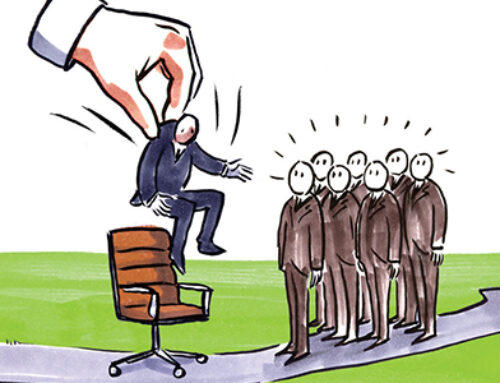Recently I met a former colleague at a Leadership Conference. After some initial small talk, he argued that nobody in the Top Management could realize that his company was driving into a dead-end street. He told me that almost everybody in the organization could see the warning signals, but those who were in the driving seats continued accelerating. “What is your perception about the leadership reality in organizations you are consulting?”, he asked me.
A few days later, I experienced a similar case during a coaching call. My client stated that she was the only Executive Board member who could realize that the organization was already at a dead-end street. But to make matters worse, all attempts to convince her colleagues to act, or at least to consider that the situation needed to be changed, did not lead to any reaction. Everything seemed to be blocked, nevertheless they just continued on endless meetings. “I don’t know what to do, I’m desperate!”, she said.
Many people know the feeling when they reach a dead-end street however, how did they get there?
What is the phenomenon of a dead-end street?
At the beginning of the road one is still convinced to be driving into the right direction but shortly before the road ends, drivers are surprised to see they reached a dead-end. There is only one way out: returning to the beginning of the same dead-end street. Drivers try to turn around, which might require a few moves, especially when more drivers missed the road sign at the beginning and block the whole road behind.
How does that work in organizations? How do leaders face this reality? Do they turn around when they reach the dead-end street?
In my opinion, in most cases, organizations search to blame and fire the driver (CEO). However, his/her car is still stuck in that dead-end street. Subsequently, organizations hire external consultants, build project teams, develop new strategies to get the situation resolved, etc. This maneuver is very time consuming and, at its best, the organization, after some trial-and-error, could be back on track.
Sometimes people work on ‘Pseudo Strategies’, instead of driving back to beginning of the road. Why don’t organizations and their leaders use the reverse gear? Is it the fear of losing power, losing the face? Is it the fear of admitting failures? I’m deeply convinced that most of organizational disasters could be avoided, if drivers would simply take notice of the warning sign at the beginning of the street, instead of driving in high speed into its dead-end.
What are those warning signs in organizations?
Unexpected boost of growth combined with a pretended urge for centralization
An unexpected boost of growth, due to the explosion of market demand, can hit an organization completely unprepared. Potential consequences are e.g. uncoordinated creation of departments, business units, divisions, country organizations, headquarters and regions – only to name a few. As the organization desperately needs people to lead those new departments there is a risk that employees get promoted into roles which exceed their competencies. As a further consequence, ‘kingdoms of power’ arise, bringing the ‘need’ for control by central functions, mainly located in headquarters. Multidimensional Matrix Organizations with unclear accountabilities/responsibilities and double dotted reporting lines show clear signs of being already half way on the dead-end street.
How to deal with this challenge?
Management Consultants support organizations building small ‘working-committees’, consisting of no more than 5 members (2 delegates from the leadership team and 3 employees with the necessary functional knowledge). Such committees work on potential solutions, involving all necessary stakeholders and have the mandate to take decisions. The ‘only’ task left for the leadership teams is to anticipate upcoming development needs and empower those committees. Successful companies manage to build units not exceeding the size of 150 people as research shows that social systems stop to function when people cannot manage their personal relationships any longer. Decision power is given to decentralized functions, embedded in a clear set of measurable goals. Central functions (headquarters) do not claim the final decision power but instead, focus on their roles to coordinate and orchestrate the different local and decentralized functions. An agile way to successfully master organizational development challenges.
Profit Greed and a lack of communication
Excessive shareholders’ budget requirements bring the risk of pushing an organization into the ‘Profit Greed Trap’. Everything is focused solely on profit growth. The original purpose of the organization seems to be forgotten and the entire personnel work for quarterly reports. The increasing need of Management to control what people are doing, leads to a further centralization of decision power. The major role of employees consists of implementing orders from headquarters. Engagement goes down, goals are missed, pressure increases. Further, cost cutting programs are implemented, unfortunately not achieving the aimed result. The organization is on a dead-end street.
How to settle this mismatch?
When different expectations clash, people seem to forget their communication skills and the need to compromise. Management feels squeezed in between shareholders’ expectations and market reality. All parties claim having the correct opinion and stick to their subjective perception. A Business Coach objectifies the different expectation levels and facilitates regular discussion rounds between shareholders, management and employees, before budget requirements are fixed. Hence, compromises can be made in a way to keep the engagement level high and protect the organization from unhealthy centralization activities.
Ignorance and Self-Importance
I learned about people driving cars into a dead-end street, pretending that they haven’t seen any road sign indicating ‘no exit’, although their car passengers warned them. Once those drivers arrive at the dead-end, some even blame the passengers for the disaster and leave the car.
Coaching could support those managers to exercise self-reflection and accept feedback. Maybe, even to realize that leading an organization requires more than only a drivers’ license. In those cases, when managers keep their denial for support and simply continue driving, passengers should leave, as there is no cure for ignorance and self-importance.
Unfortunately, Consultants and Coaches are mostly called when the car has already reached the dead-end street.
What a waste of resources could be avoided by contacting them already when the first warning signs pop up!




